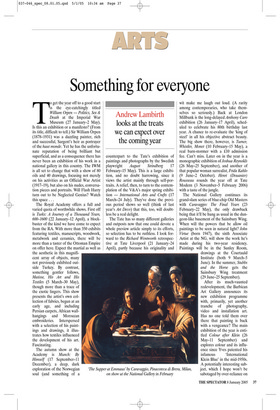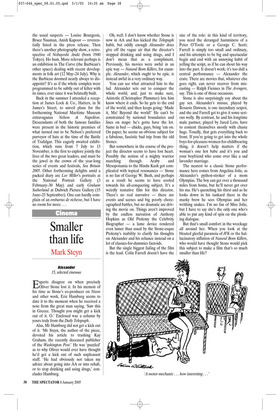Something for everyone
Andrew Lambirth looks at the treats we can expect over the coming year
To get the year off to a good start is the eye-catchingly titled William Orpen — Politics, Sex & Death at the Imperial War Museum (27 January–2 May). Is this an exhibition or a manifesto? (From its title, difficult to tell.) Sir William Orpen (1878–1931) was a dazzling painter, rich and successful, Sargent’s heir as portrayer of the haut monde. Yet he has the unfortunate reputation of being brilliant but superficial, and as a consequence there has never been an exhibition of his work in a national gallery in this country. The IWM is all set to change that with a show of 80 oils and 40 drawings, focusing not merely on his activities as an Official War Artist (1917–19), but also on his nudes, conversation pieces and portraits. Will Flash Harry turn out to be Neglected Genius? Watch this space ...
The autumn show at the Academy is Munch: By Himself (17 September–11 December), a deep, dark exploration of the Norwegian soul (and something of a counterpart to the Tate’s exhibition of paintings and photographs by the Swedish playwright August Strindberg 17 February–15 May). This is a large exhibition, and no doubt harrowing, since it views the artist mainly through self-portraits. A relief, then, to turn to the contemplation of the V&A’s major spring exhibition — International Arts and Crafts (17 March–24 July). They’ve done the previous period shows so well (think of last year’s Art Deco) that this, too, will doubtless be a real delight.
The Tate has so many different galleries and outposts now that one could devote a whole preview article simply to its efforts, so selection has to be ruthless. I look forward to the Richard Wentworth retrospective at Tate Liverpool (21 January–24 April), partly because his originality and wit make me laugh out loud. (A rarity among contemporaries, who take themselves so seriously.) Back at London Millbank is the long-delayed Anthony Caro exhibition (26 January–17 April), scheduled to celebrate his 80th birthday last year. A chance to re-evaluate the ‘king of steel’ in all his objective abstract beauty. The big show there, however, is Turner, Whistler, Monet (10 February–15 May), a real barn-stormer with a £10 admission fee. Can’t miss. Later on in the year is a monographic exhibition of Joshua Reynolds (26 May–25 September), and another of that popular woman surrealist, Frida Kahlo (9 June–2 October). Henri (Douanier) Rousseau rounds the year off at Tate Modern (3 November–5 February 2006) with a taste of the jungle.
The National Gallery continues its grand-slam series of blue-chip Old Masters with Caravaggio: The Final Years (23 February–22 May), the only drawback being that it’ll be hung as usual in the dungeon-like basement of the Sainsbury Wing. When will the powers that be allow oil paintings to be seen in natural light? John Virtue (born 1947), the sixth Associate Artist at the NG, will show the work he’s made during his two-year residency. Paintings will be in the Sunley Room, drawings at the Courtauld Institute (both 9 March–5 June). In the summer, Stubbs and the Horse gets the Sainsbury Wing treatment (29 June–25 September).
After its much-vaunted redevelopment, the Barbican Art Gallery announces its new exhibition programme with, primarily, yet another tranche of photography, video and installation art. Has no one told them over there that painting is back with a vengeance? The main exhibition of the year is entitled Colour after Klein (26 May–11 September) and explores colour and its influence since Yves patented his infamous ‘International Klein Blue’ in the mid-1950s. A potentially interesting subject, which I hope won’t be sabotaged by over-reliance on the usual suspects — Louise Bourgeois, Bruce Nauman, Anish Kapoor — reverentially listed in the press release. Then there’s another photography show, a retrospective of Nobuyoshi Araki (born 1940 Tokyo). Ho hum. More relevant perhaps is an exhibition in The Curve (the Barbican’s other space) dealing with recent developments in folk art (12 May–24 July). Why is the Barbican doomed nearly always to disappoint? It’s as if the whole complex were programmed to be subtly out of kilter with its times, ever since it was belatedly built.
Back in the summer I attended a reception at James Lock & Co., Hatters, in St James’s Street, to unveil plans for the forthcoming National Maritime Museum extravaganza Nelson & Napoléon. Descendants of both the famous families were present in the historic premises of what turned out to be Nelson’s preferred purveyor of hats at the time of the Battle of Trafalgar. This eagerly awaited exhibition, which runs from 7 July to 13 November, is the first to explore jointly the lives of the two great leaders, and must be the jewel in the crown of the year-long series of events and festivals, Sea Britain 2005. Other forthcoming delights amid a packed diary are Lee Miller’s portraits at the National Portrait Gallery (3 February–30 May) and early Graham Sutherland at Dulwich Picture Gallery (15 June–25 September). One can hardly complain of an embarras de richesse, but I have no room for more ...











































 Previous page
Previous page